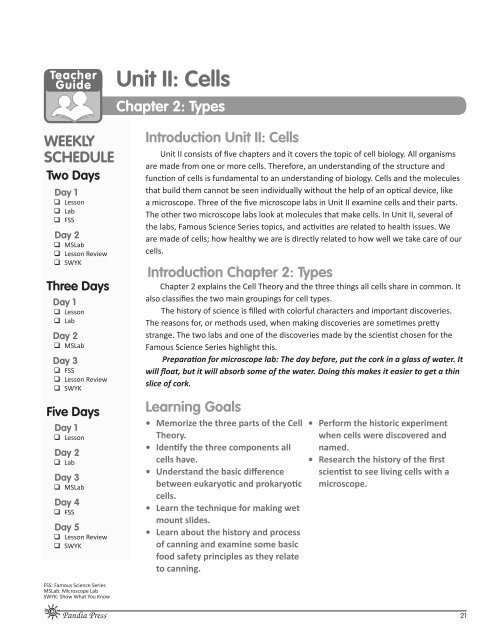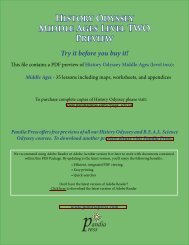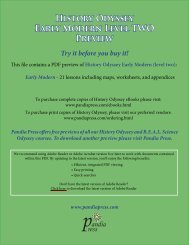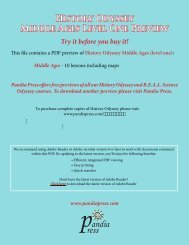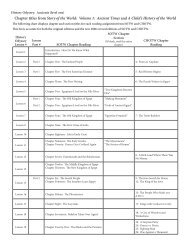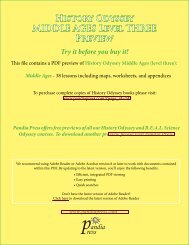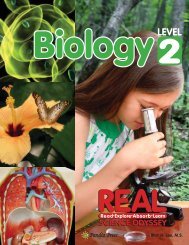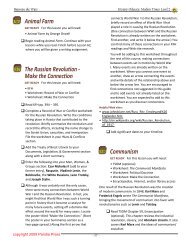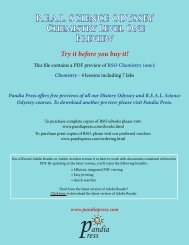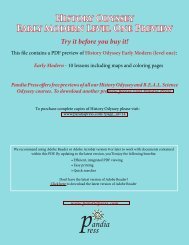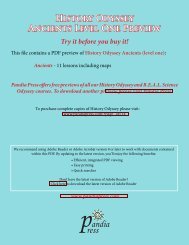REAL Science Odyssey Biology 2 Teacher Guide ... - Pandia Press
REAL Science Odyssey Biology 2 Teacher Guide ... - Pandia Press
REAL Science Odyssey Biology 2 Teacher Guide ... - Pandia Press
You also want an ePaper? Increase the reach of your titles
YUMPU automatically turns print PDFs into web optimized ePapers that Google loves.
<strong>Teacher</strong><br />
<strong>Guide</strong><br />
WEEKLY<br />
SCHEDULE<br />
Two Days<br />
Day 1<br />
q Lesson<br />
q Lab<br />
q FSS<br />
Day 2<br />
q MSLab<br />
q Lesson Review<br />
q SWYK<br />
Three Days<br />
Day 1<br />
q Lesson<br />
q Lab<br />
Day 2<br />
q MSLab<br />
Day 3<br />
q FSS<br />
q Lesson Review<br />
q SWYK<br />
Five Days<br />
Day 1<br />
q Lesson<br />
Day 2<br />
q Lab<br />
Day 3<br />
q MSLab<br />
Day 4<br />
q FSS<br />
Day 5<br />
q Lesson Review<br />
q SWYK<br />
Unit II: Cells<br />
Chapter 2: Types<br />
Introduction Unit II: Cells<br />
Unit II consists of five chapters and it covers the topic of cell biology. All organisms<br />
are made from one or more cells. Therefore, an understanding of the structure and<br />
funcon of cells is fundamental to an understanding of biology. Cells and the molecules<br />
that build them cannot be seen individually without the help of an opcal device, like<br />
a microscope. Three of the five microscope labs in Unit II examine cells and their parts.<br />
The other two microscope labs look at molecules that make cells. In Unit II, several of<br />
the labs, Famous <strong>Science</strong> Series topics, and acvies are related to health issues. We<br />
are made of cells; how healthy we are is directly related to how well we take care of our<br />
cells.<br />
Introduction Chapter 2: Types<br />
Chapter 2 explains the Cell Theory and the three things all cells share in common. It<br />
also classifies the two main groupings for cell types.<br />
The history of science is filled with colorful characters and important discoveries.<br />
The reasons for, or methods used, when making discoveries are somemes prey<br />
strange. The two labs and one of the discoveries made by the scienst chosen for the<br />
Famous <strong>Science</strong> Series highlight this.<br />
Preparaon for microscope lab: The day before, put the cork in a glass of water. It<br />
will float, but it will absorb some of the water. Doing this makes it easier to get a thin<br />
slice of cork.<br />
Learning Goals<br />
• Memorize the three parts of the Cell<br />
Theory.<br />
• Idenfy the three components all<br />
cells have.<br />
• Understand the basic difference<br />
between eukaryoc and prokaryoc<br />
cells.<br />
• Learn the technique for making wet<br />
mount slides.<br />
• Learn about the history and process<br />
of canning and examine some basic<br />
food safety principles as they relate<br />
to canning.<br />
• Perform the historic experiment<br />
when cells were discovered and<br />
named.<br />
• Research the history of the first<br />
scienst to see living cells with a<br />
microscope.<br />
FSS: Famous <strong>Science</strong> Series<br />
MSLab: Microscope Lab<br />
SWYK: Show What You Know<br />
<strong>Pandia</strong> <strong>Press</strong> 21


